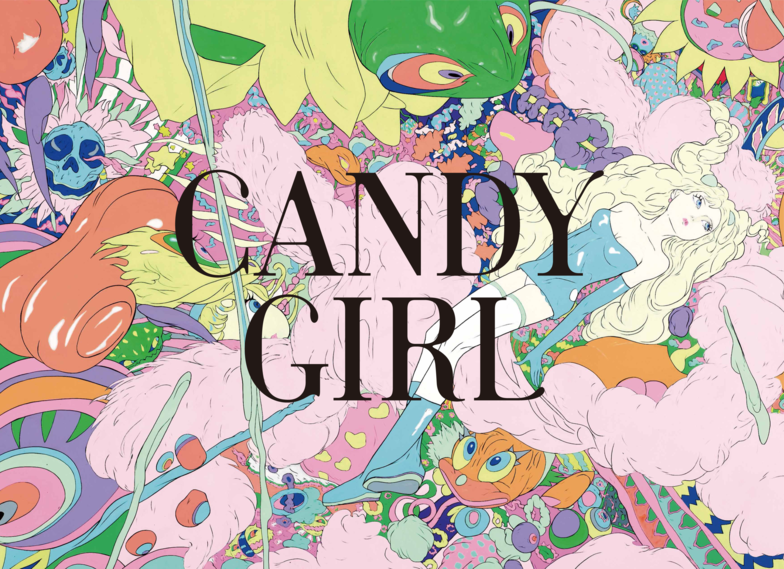We launched " CANDY GIRL " (108 girls representing earthly desires), the new work by Yoshitaka Amano, illustrator of Final Fantasy, within a fashion context. For the first phase, we collaborated with Mitsukoshi Isetan, designing and selling a total of 50 brands and approximately 200 items. This included in-store decorations, as well as the hanging banner and window display production for Ginza 4-chome. The project expanded to Nihonbashi, Shinjuku, and Nagoya.
Tokyu Corporation "MASS RHYTHM"
We created an installation that converts the cyclical flow of people crossing the scramble intersection into real-time art and sound. It extracts the colors of the fashion worn by people crossing the intersection, visualizing these color cubes on a timeline. It reads the volume and movement of people to play melodies, while the cycle of the traffic light changing from blue to red becomes an endless musical phrase. Personally, I wanted to transform the chaotic scramble intersection, which I found unpleasant, into a comfortable space.
The perception of luxury is undergoing a significant shift.
DECODED FASHION (hereafter DF) is a global event connecting technology and fashion, founded in the US in 2011. DF's activities span 12 countries worldwide, including New York, London, and Milan. Most recently, it played a pioneering role in establishing the fashion division at South by Southwest (SXSW) in March last year, generating significant buzz.
This year's Tokyo event theme is "The Future of Luxury Experiences." Now that we can be connected 24/7 through technology, I believe people's perception of luxury is undergoing a major shift. I've considered the factors driving this change from my own perspective.
・Generation Z and SNS
Sharing one's image on SNS is now commonplace. I interpret SNS as a second Saha world (in my heart's voice). The origin of "Saha" comes from the Sanskrit word "saha" (endurance). In Buddhist terminology, it seems to refer to a world without freedom. Now, I don't mean to suddenly diss it, but while SNS may seem like a free world at first glance, I think behavior there can potentially influence the real world in some way. How does Generation Z perceive the boundary between these two worlds?
While spending vast amounts of time in the real world, they present only selected fragments of it in their second Saha world. Generation Z seems naturally adept at this selection—this editing—and it feels as if they've been conditioned to see their very existence as self-branding.
・Fashion's "Informationization"
Normcore and ethical fashion were popular, but recently, high-impact fashion has taken center stage. You see clothes printed with playful motifs like cats, stars, or human faces, extreme silhouettes, and people sporting pink or blue hair on the streets. Taking photos and sharing them has become the norm. Perhaps the value of how something looks in a photo, and the subsequent "likes" it receives when shared, has increased significantly.
High-end brand collections often stage venues where every attendee can see the front row. While this allows guests to examine details up close, some theories suggest it's also to enable them to take and share photos from the best angles.
Now that we've become "information-clad," I believe multiple axes have emerged in fashion's value criteria. Beyond design, functionality, quality, price, philosophy, trends, and sustainability, we now factor in information dissemination power. We can no longer measure it solely by the price tag on the garment. We almost need a new unit that instantly reveals this multi-dimensional value. But I also think we must still engage our brains and sensibilities...
・Technology-Driven Democratized Luxury
When traveling, I absolutely love visiting shops run by local fashion designers and creators. The living environment—the streets, weather, food, and people—differs completely from country to country, and I believe this seeps into everything: the designs, color palettes, materials, and even the shop's atmosphere.
Lately, I keep finding myself drawn to the app "FARFETCH." It lets you shop online from local select shops around the world. It feels like peeking into a shop tucked away in a London alleyway while still in Japan. It's a fashion experience like a "Fashion Passport." Technology is democratizing, making luxury instantly accessible to anyone, anywhere. Democra-luxury.
■ Buying "experiences" rather than "things" is the new luxury
With information transparency now the norm, we can discern what constitutes luxury for ourselves in high definition. It doesn't feel like luxury is simply about spending money.
Last year, I went to Boston via Airbnb. My accommodation was a spacious, tastefully decorated house with art pieces, essentially a private rental. The grandmother who lived there shared local restaurant and shop recommendations, inviting me back. It felt like gaining a distant relative—a deeply personal, one-of-a-kind experience. Emotional luxury.
Where tech-driven democratized luxury meets authentic, emotional luxury—that's where experiences truly sink into our lives, bodies, and memories, becoming deeper.
I feel this points toward the luxury of the future.
"Disorder is true luxury" by Coco Chanel
Coco Chanel liberated women by inventing comfortable jersey fabrics, menswear-inspired clothing, and lipstick—now commonplace—freeing them from constricting corsets.
Fashion, I believe, only truly comes alive when it engages with the society and relationships surrounding it, not just as an object itself. Chanel, who overturned the context of her era, was a designer, a businesswoman, and an innovator.
What would she do in today's world?
I think accepting the ordinary would be the end.
What will happen next? Is there something hidden behind the seemingly ordinary days we live?
Try breaking the order. There might lie a hint to luxury.
DECODED FASHION 2016 is finally here. With technology becoming commonplace, I feel we might see more fundamental discussions. I'm looking forward to seeing what kind of disruption unfolds.



